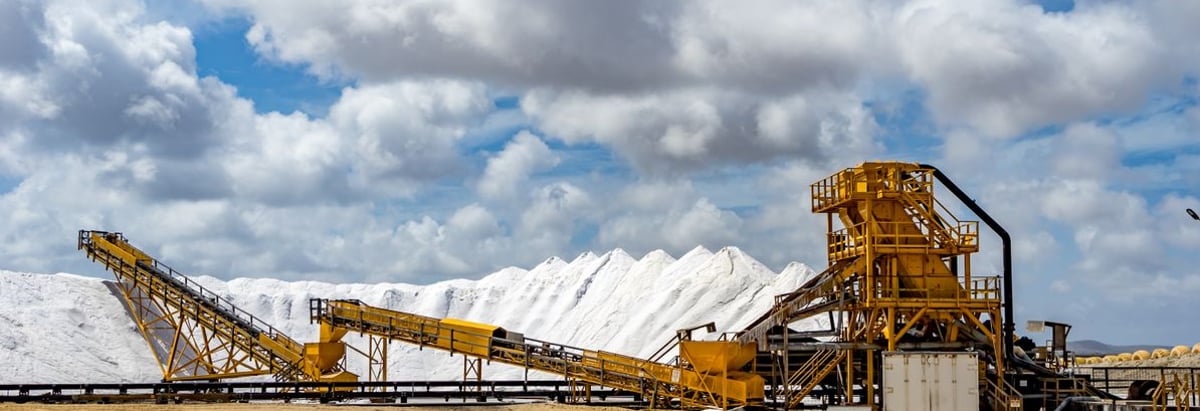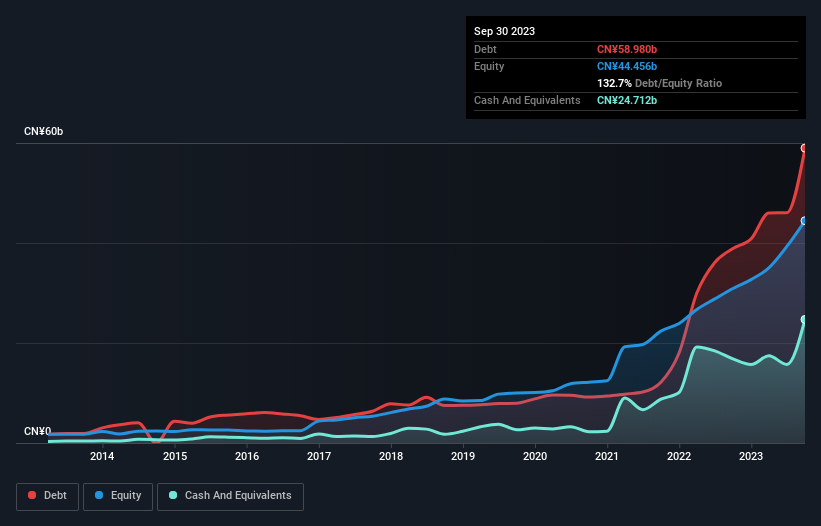- China
- /
- Electrical
- /
- SHSE:603799
Zhejiang Huayou Cobalt (SHSE:603799) Use Of Debt Could Be Considered Risky

The external fund manager backed by Berkshire Hathaway's Charlie Munger, Li Lu, makes no bones about it when he says 'The biggest investment risk is not the volatility of prices, but whether you will suffer a permanent loss of capital.' When we think about how risky a company is, we always like to look at its use of debt, since debt overload can lead to ruin. As with many other companies Zhejiang Huayou Cobalt Co., Ltd (SHSE:603799) makes use of debt. But is this debt a concern to shareholders?
When Is Debt Dangerous?
Debt and other liabilities become risky for a business when it cannot easily fulfill those obligations, either with free cash flow or by raising capital at an attractive price. If things get really bad, the lenders can take control of the business. However, a more common (but still painful) scenario is that it has to raise new equity capital at a low price, thus permanently diluting shareholders. By replacing dilution, though, debt can be an extremely good tool for businesses that need capital to invest in growth at high rates of return. The first thing to do when considering how much debt a business uses is to look at its cash and debt together.
See our latest analysis for Zhejiang Huayou Cobalt
What Is Zhejiang Huayou Cobalt's Debt?
As you can see below, at the end of September 2023, Zhejiang Huayou Cobalt had CN¥59.0b of debt, up from CN¥38.9b a year ago. Click the image for more detail. However, because it has a cash reserve of CN¥24.7b, its net debt is less, at about CN¥34.3b.

How Healthy Is Zhejiang Huayou Cobalt's Balance Sheet?
According to the last reported balance sheet, Zhejiang Huayou Cobalt had liabilities of CN¥53.0b due within 12 months, and liabilities of CN¥36.4b due beyond 12 months. On the other hand, it had cash of CN¥24.7b and CN¥10.9b worth of receivables due within a year. So it has liabilities totalling CN¥53.8b more than its cash and near-term receivables, combined.
When you consider that this deficiency exceeds the company's CN¥49.3b market capitalization, you might well be inclined to review the balance sheet intently. Hypothetically, extremely heavy dilution would be required if the company were forced to pay down its liabilities by raising capital at the current share price.
We use two main ratios to inform us about debt levels relative to earnings. The first is net debt divided by earnings before interest, tax, depreciation, and amortization (EBITDA), while the second is how many times its earnings before interest and tax (EBIT) covers its interest expense (or its interest cover, for short). The advantage of this approach is that we take into account both the absolute quantum of debt (with net debt to EBITDA) and the actual interest expenses associated with that debt (with its interest cover ratio).
Zhejiang Huayou Cobalt has net debt to EBITDA of 4.6 suggesting it uses a fair bit of leverage to boost returns. On the plus side, its EBIT was 8.1 times its interest expense, and its net debt to EBITDA, was quite high, at 4.6. Shareholders should be aware that Zhejiang Huayou Cobalt's EBIT was down 31% last year. If that decline continues then paying off debt will be harder than selling foie gras at a vegan convention. The balance sheet is clearly the area to focus on when you are analysing debt. But ultimately the future profitability of the business will decide if Zhejiang Huayou Cobalt can strengthen its balance sheet over time. So if you want to see what the professionals think, you might find this free report on analyst profit forecasts to be interesting.
Finally, a company can only pay off debt with cold hard cash, not accounting profits. So it's worth checking how much of that EBIT is backed by free cash flow. During the last three years, Zhejiang Huayou Cobalt burned a lot of cash. While investors are no doubt expecting a reversal of that situation in due course, it clearly does mean its use of debt is more risky.
Our View
To be frank both Zhejiang Huayou Cobalt's conversion of EBIT to free cash flow and its track record of (not) growing its EBIT make us rather uncomfortable with its debt levels. But on the bright side, its interest cover is a good sign, and makes us more optimistic. After considering the datapoints discussed, we think Zhejiang Huayou Cobalt has too much debt. While some investors love that sort of risky play, it's certainly not our cup of tea. When analysing debt levels, the balance sheet is the obvious place to start. However, not all investment risk resides within the balance sheet - far from it. These risks can be hard to spot. Every company has them, and we've spotted 4 warning signs for Zhejiang Huayou Cobalt (of which 1 is concerning!) you should know about.
At the end of the day, it's often better to focus on companies that are free from net debt. You can access our special list of such companies (all with a track record of profit growth). It's free.
Valuation is complex, but we're here to simplify it.
Discover if Zhejiang Huayou Cobalt might be undervalued or overvalued with our detailed analysis, featuring fair value estimates, potential risks, dividends, insider trades, and its financial condition.
Access Free AnalysisHave feedback on this article? Concerned about the content? Get in touch with us directly. Alternatively, email editorial-team (at) simplywallst.com.
This article by Simply Wall St is general in nature. We provide commentary based on historical data and analyst forecasts only using an unbiased methodology and our articles are not intended to be financial advice. It does not constitute a recommendation to buy or sell any stock, and does not take account of your objectives, or your financial situation. We aim to bring you long-term focused analysis driven by fundamental data. Note that our analysis may not factor in the latest price-sensitive company announcements or qualitative material. Simply Wall St has no position in any stocks mentioned.
About SHSE:603799
Zhejiang Huayou Cobalt
Engages in the research, development, manufacture, and sale of lithium battery materials and cobalt materials in China and internationally.
Undervalued average dividend payer.

